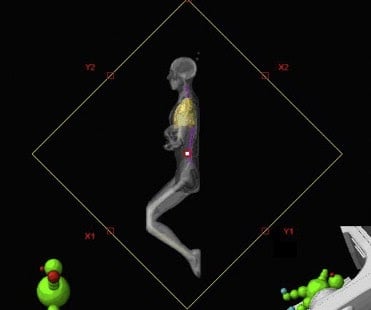A Discussion with Nels Knutson and Geoff Hugo on Radiotherapy for Ventricular Tachycardia
Tyler Blackwell hosts Nels Knutson and Geoff Hugo of Washington University on the topic of Ventricular Tachycardia.
Texas Oncology perfects the art of total body irradiation with EZFluence.
EZFluence is a Radformation mainstay, a popular automation tool that serves many purposes in the clinic. It makes short work of 3D planning, automating the tedious and time-consuming work involved with field-in-field generation.
But more than that, it makes fluence editing a breeze for electronic compensation plans for faster treatment planning for virtually any 3D case. Users are finding it useful for hybrid-IMRT plans too, and creating justification plans for insurance is fast and easy. But there’s a technique you may not have guessed was in the EZFluence playbook: total body irradiation.
Total body irradiation (TBI) is the delivery of full-body irradiation, most commonly used prior to bone marrow transplantation to suppress the immune system to prevent the rejection of donor marrow. A number of techniques have been devised to deliver radiation to the body and provide the dose homogeneity required. A 2012 Study showed feasibility using a field-in-field approach for TBI, and others have suggested the technique helps with uniformity for large-separation patients. As it turns out, that’s how they’ve been doing it at Texas Oncology for the last decade.

While other planning techniques involve transmission blocks or rice bags to make the dose more uniform for the head, feet, and neck, the team at Texas Oncology prefers manipulating dose using MLC subfields. The process starts with a whole-body scan in the treatment position. For treatment planning, they place the calculation point in the thickest part of the body, in their case from the side at the elbow, and calculate the fluence for open fields at an extended distance.
At this point, they invoke EZFluence to edit the fluence to achieve 90% dose coverage to 100% of the body, ensuring there are no cold spots. With a little blocking to cool the plan where necessary, the plan is ready for treatment. Patients are treated lying on a stretcher, which rotates 180° to allow two lateral beams. With no accessories to fuss with, the treatment process requires less effort and time.
Given that they treat 50-60 TBI cases per year at Texas Oncology, they need a smooth process. By automating field-in-field segments using EZFluence, they’ve found a technique that simplifies the treatment process—without compromising plan quality—not only for the therapists but also for their patients.

Tyler is a board-certified medical physicist with extensive clinical experience in radiation therapy. He is active in the medphys community including several AAPM committees, the AAPM Board of Directors, and as an ABR orals examiner. Tyler dabbles in real estate investing, loves preparing breakfast for his three kiddos, and enjoys playing adult coed soccer.
Related tags: Treatment Planning
Tyler Blackwell hosts Nels Knutson and Geoff Hugo of Washington University on the topic of Ventricular Tachycardia.
We had an excellent meeting in the windy city! ASTRO 2019 was filled with groundbreaking research, collaborative learning, and interesting new...
A realistic inquiry into the clinical realities of adaptive radiotherapy, examining the pitfalls and promise of this game-changing treatment approach.
Leave a comment